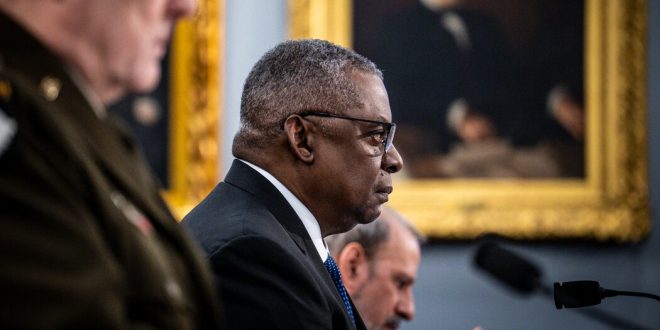WASHINGTON — The main air defense system at a coalition military base in northeast Syria was “not fully operational” when a suspected Iranian drone hit the installation, killing a U.S. contractor and injuring six other Americans, two U.S. officials said on Friday.
It was unclear why the system was not fully functional and what difference that made in defending the base from the attack on Thursday. Brig. Gen. Patrick Ryder, the Pentagon spokesman, said on Friday that the air defense’s radar was working but he declined to discuss any other details of the system, citing operational security and an investigation by the military’s Central Command.
It was also unclear whether the attackers had detected that vulnerability and exploited it, or just happened to send the drone at that time, said officials who spoke on condition of anonymity to discuss the ongoing investigation.
The United States launched retaliatory attacks about 13 hours after the drone strike, with two Air Force F-15E fighter jets hitting a munition warehouse and a control building nearby, and an intelligence-collection site in eastern Syria, two senior U.S. military officials said.
U.S. forces in northeast Syria have been on high alert against attacks from Iran-backed militias given that there have been 78 such attacks since January 2021, officials said. But the Avenger missile defense system at the coalition base, called RLZ, may have been experiencing a maintenance problem at the time of the attack, one of the U.S. officials said.
The base near Hasakah has other defenses against air and other attacks, but even all those systems combined are not foolproof, officials said. Pentagon and other American officials said they were reluctant to discuss any possible weaknesses or failings in the layered defense network to avoid giving adversaries in the region any advantage.
“We take a variety of measures to safeguard our people, but again, it’s an inherently dangerous place,” General Ryder said.
More on U.S. Armed Forces
The fighting threatens to upend recent efforts to de-escalate tensions across the wider Middle East, whose rival powers, including Iran and Saudi Arabia, have made steps toward rapprochement in recent days after years of turmoil.
General Ryder on Friday sought to tamp down fears that tit-for-tat strikes between the United States and Iran-backed groups could spiral out of control, while at the same time warning Tehran to rein in its proxies.
“We do not seek conflict with Iran. We don’t seek escalation with Iran,” General Ryder told reporters at the Pentagon. “But the strikes that we took last night were intended to send a very clear message that we take the protection of our personnel seriously, and that we will respond quickly and decisively if they’re threatened.”
Asked whether the United States holds Tehran responsible for the death of an American citizen, General Ryder said, “Iran certainly backs these groups, and by default, therefore has a responsibility to ensure that they’re not contributing to insecurity, instability. But clearly, they continue to do that.”
After U.S. intelligence analysts concluded that the drone was of “Iranian origin” — a claim the Pentagon made without any supporting evidence — the United States retaliated by launching airstrikes against militant sites linked to Iran’s Islamic Revolutionary Guards Corps, General Ryder said.
“As President Biden has made clear, we will take all necessary measures to defend our people and will always respond at a time and place of our choosing,” Defense Secretary Lloyd J. Austin III said Thursday. “No group will strike our troops with impunity.”
What we consider before using anonymous sources. Do the sources know the information? What’s their motivation for telling us? Have they proved reliable in the past? Can we corroborate the information? Even with these questions satisfied, The Times uses anonymous sources as a last resort. The reporter and at least one editor know the identity of the source.
The U.S. airstrikes killed eight pro-Iran fighters, according to the Syrian Observatory for Human Rights, a group in Britain that tracks the conflict through contacts in Syria. General Ryder said the military was still investigating reports of casualties on the ground.
U.S. military officials said that Iran-backed militias on Friday morning fired 10 rockets at a second U.S. base in the area, called Green Village, in response to the airstrikes. The officials said there were no U.S. casualties from those attacks.
Charles Lister, the director of the Syria and Countering Terrorism and Extremism programs at the Middle East Institute in Washington, said that the targeted American retaliatory strikes were important but unlikely enough to deter Iran’s behavior or the actions of its proxies.
“Until Iran senses that such attacks reap unsustainable consequences, they will continue,” Mr. Lister said in an email. “That presents President Biden with a political question: Is he willing to push back more determinedly to assert a deterrent effect, or are we willing to allow these repeated attacks on U.S. forces?”
The Islamic Revolutionary Guards Corps is a powerful branch of Iran’s armed forces that operates in parallel with the military. It is charged with securing Iran’s borders, and its overseas arm, the Quds Force, carries out operations across the Middle East and beyond, and trains and arms Shiite proxy militias that operate in a number of countries. The U.S. has designated it a terrorist group.
Iran has built increasingly sophisticated weapons-capable drones in recent years. It has both sold them commercially to other nations, including to Russia for use in the war in Ukraine, and stepped up their transfer to proxy groups.
The drones are part of a rapidly evolving threat from Iranian proxies in Syria, with militia forces specialized in operating more sophisticated weaponry hitting some of the most sensitive American targets in attacks that evaded U.S. defenses.
Two of the wounded U.S. service members were treated on site, while the three other service members and the contractor were medically evacuated to coalition medical facilities in Iraq. The Pentagon did not identify the contractor who was killed, pending notification of family, a senior military official said.
America still has more than 900 troops, and hundreds more contractors, in Syria, working with Kurdish fighters to make sure there is no resurgence of the Islamic State, which was ostensibly defeated as a self-declared caliphate in 2019, after five years of wreaking havoc across Iraq and Syria.
Iranian-backed militias have launched dozens of attacks at or near bases where U.S. troops are in the past year alone. Since January 2021, Gen. Michael E. Kurilla, the head of the Central Command, said Iran-backed groups had carried out 78 attacks against Americans before Thursday’s strike.
“Iran’s vast and deeply resourced proxy forces spread instability throughout the region and threaten our regional partners,” General Kurilla, who earlier this month visited the same base in northeast Syria that was attacked, told the House Armed Services Committee on Thursday.
U.S. and partner forces with a coalition that includes the Kurdish Syrian Democratic Forces have been working together to keep pressure on Islamic State militants and to ensure that detained fighters do not end up back on the battlefield.
The Kurdish Syrian forces conduct targeted raids against Islamic State members. They also guard more than 10,000 imprisoned Islamic State fighters, while the Pentagon and American troops provide air support, intelligence and reconnaissance.
With the Biden administration focused on Russia’s invasion of Ukraine and a potential future conflict with China, the counter-Islamic State military mission in Syria has become something of a back-burner issue.
The mission has received greater attention only when Iranian-backed militias or Islamic State militants attack the American troops who rotate in and out, for nine months at a time, across a handful of bases in northeast Syria, which Gen. Mark A. Milley, the chairman of the Joint Chiefs of Staff, visited this month.
The United States has repeatedly carried out airstrikes in response. In June 2021, it struck facilities used by two Iranian-backed militias in Iraq and Syria that the Pentagon said had conducted drone strikes against American personnel in Iraq. In December 2019, the U.S. military struck five targets in Iraq and Syria controlled by an Iranian-backed paramilitary group in retaliation for a rocket attack that killed an American contractor.
John Yoon contributed reporting from Seoul.
 Top Naija News: Nigerian News, Breaking News Nigeria and World News Top Naija News is a daily news publication in Nigeria, delivering the latest breaking news in Nigeria and around the world.
Top Naija News: Nigerian News, Breaking News Nigeria and World News Top Naija News is a daily news publication in Nigeria, delivering the latest breaking news in Nigeria and around the world.




